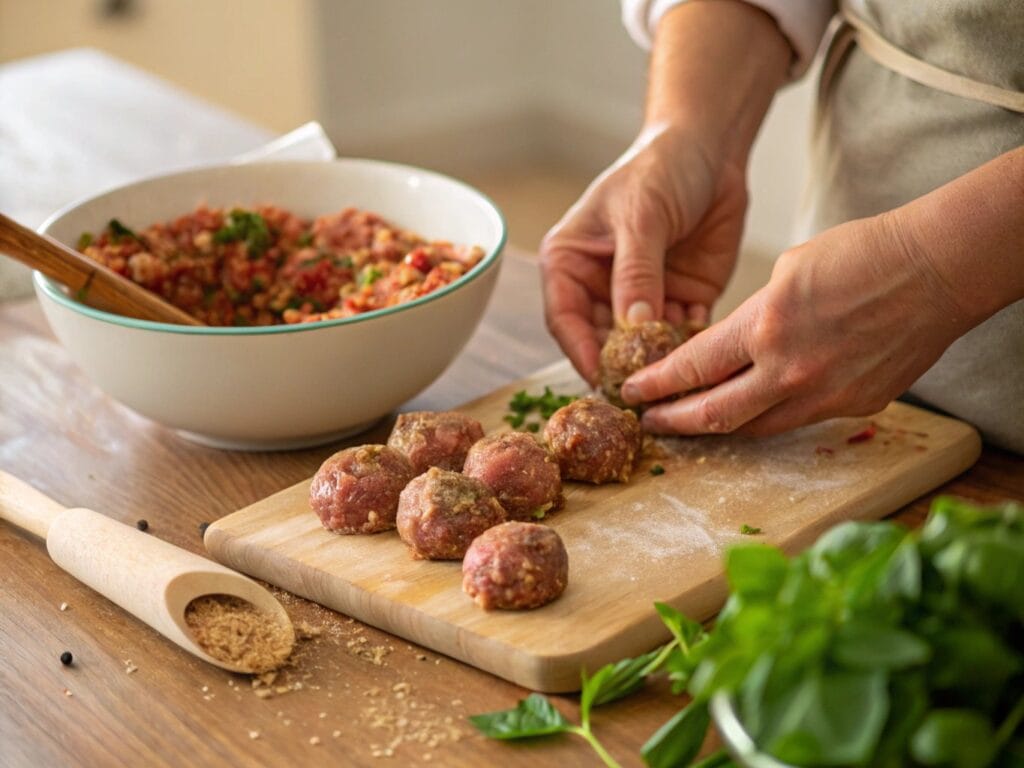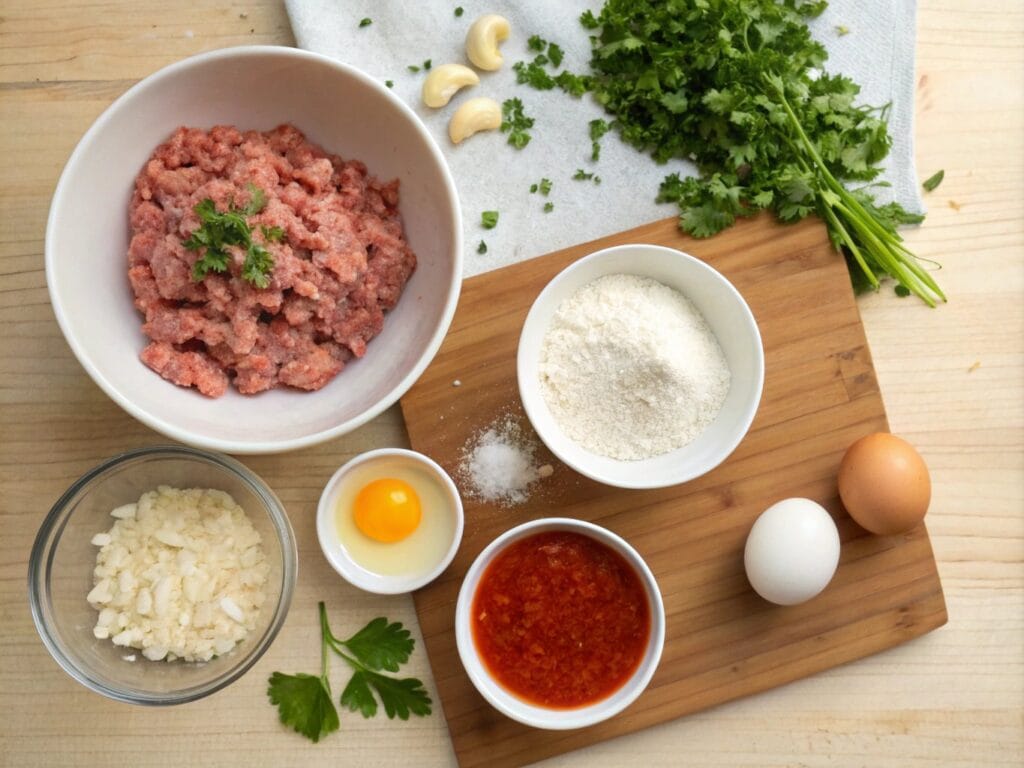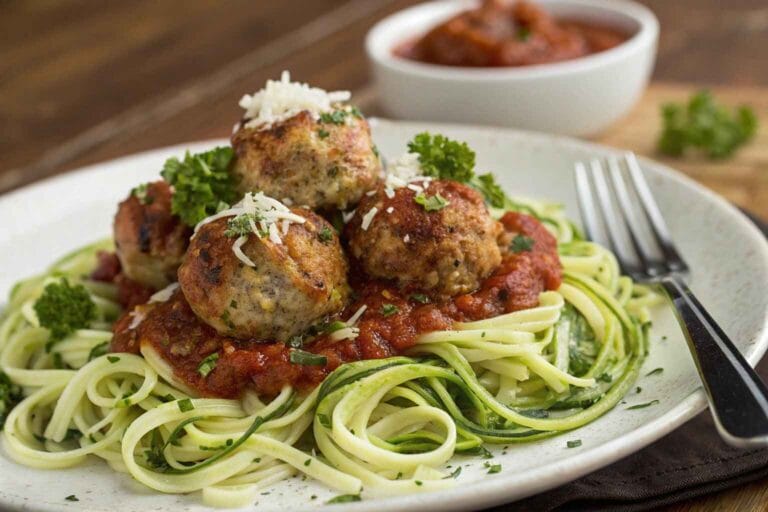Gluten free meatballs aren’t just a substitute for traditional recipes—they’re a game-changer in the kitchen. Whether you’re managing a gluten intolerance, experimenting with healthier options, or just trying something new, Meatball recipe without gluten offer a flavorful and versatile solution for your meals. Let’s dive into what makes them so special and how you can master the art of making them!
Table of Contents
What Makes Gluten Free Meatballs Unique?
Understanding Gluten and Its Impact on Health
Gluten, a protein found in wheat, barley, and rye, is harmless for most people. However, for those with celiac disease or gluten sensitivity, it can cause a range of serious health problems. These include digestive distress, inflammation, and other uncomfortable symptoms that can significantly impact daily life.
That’s why switching to gluten-free options is more than just avoiding problems—it’s a smart way to enjoy foods that truly support your health. Gluten-free meatballs are a great choice because they give you all the tasty flavors of regular meatballs without any of the risks that come with gluten. With these delicious alternatives, you can enjoy every bite without giving up on flavor or health, making them a perfect addition to your meals.
“Switching to gluten free isn’t about restriction—it’s about finding better alternatives that work for you.”
Why choose gluten-free meatballs for your diet?
It’s a great question, and the answer is simple—they’re totally worth it!
First of all, they’re full of flavor. You won’t even miss the gluten because they’re just as delicious as the traditional ones. Plus, they’re healthier. By skipping processed binders and fillers, you’re making a choice that’s better for your body.
But that’s not all! These meatballs are incredibly flexible. Gluten-free recipes let you get creative and add your own twist, whether it’s new spices, fresh herbs, or unique ingredients.
So, it’s not just about avoiding gluten. It’s about exploring new, exciting ways to enjoy a classic dish while staying healthy and satisfied!
Ingredients for Perfect Gluten Free Meatballs

Best Gluten-Free Binders for Meatballs
The key to healthy meatball options lies in finding the right binders to replace traditional breadcrumbs. Some great options include:
- Almond Flour: Adds a nutty flavor and keeps the meatballs tender.
- Ground Oats: A classic gluten free choice for structure.
- Crushed Rice Crackers: Light and crunchy, perfect for binding.
- Mashed Potatoes or Sweet Potatoes: A creative twist that adds moisture and flavor.
Each of these options works beautifully to hold your meatballs together while adding subtle flavor enhancements.
Choosing the Right Type of Meat
Your choice of meat sets the foundation for the texture and flavor of your homemade allergen-friendly meatballs. Here’s a quick guide:
- Beef: A classic choice for hearty, flavorful meatballs.
- Turkey or Chicken: Perfect for lighter, leaner versions.
- Pork: Adds moisture and richness.
- A Blend: Combining meats (like beef and pork) creates depth and complexity.
Adding Flavor: Spices, Herbs, and Add-Ins
The best meatballs are bursting with flavor. Don’t be shy—experiment with fresh herbs like parsley and basil, bold spices like paprika or cumin, and extras like grated Parmesan cheese or minced garlic.
Step-by-Step Recipe for Gluten Free Meatballs
Preparing the Ingredients
Start by gathering your ingredients. Here’s a basic shopping list for gluten free meatballs:
- 1 pound of ground beef or a meat blend.
- 1/4 cup almond flour or your chosen binder.
- 1 egg (or flax egg for a vegan option).
- 2 cloves of garlic, minced.
- 2 tablespoons fresh parsley, chopped.
- 1 teaspoon Italian seasoning.
- Salt and pepper to taste.
Pro Tip: Let your ground meat rest at room temperature for about 15 minutes before mixing. This step ensures even cooking and a better texture.
Mixing and Shaping the Meatballs
Combine all the ingredients in a large bowl. Using your hands (yes, it gets a little messy!), mix until just combined—overmixing can make the meatballs dense.
Once mixed, scoop out small portions and roll them gently between your palms to form uniform balls. Aim for golf-ball-sized portions for even cooking.
“Perfectly round meatballs are like little gifts of flavor—carefully crafted and always appreciated.”🎁
Cooking Methods: Baking, Frying, or Slow Cooking
Choose your favorite method to cook the meatballs:
- Baking: Line a baking sheet with parchment paper and bake at 375°F (190°C) for 20-25 minutes. This is the easiest and least messy option.
- Frying: Heat a skillet with a splash of oil and sear the meatballs until browned on all sides. This method adds a delicious crust.
- Slow Cooking: Add your meatballs to a slow cooker with your favorite gluten free sauce and cook on low for 6-8 hours. The result? Juicy, tender perfection.
Looking for more ways to make gluten-free meatballs? Check out this Meatball Recipe Without Breadcrumbs for even more tips and ideas.

Tips for Making the Perfect Gluten Free Meatballs
Avoiding Common Mistakes in Gluten Free Cooking
Gluten free recipes can sometimes be tricky, but don’t worry—you’ve got this! Here are a few tips:
- Don’t skip the binder: Even if it’s gluten free, a binder is crucial for structure.
- Season generously: Gluten free binders can be bland, so add extra spices to balance things out.
How to Keep Meatballs Moist and Flavorful
Dry meatballs? Nobody wants that. To keep them moist:
- Add a splash of milk or a dairy-free alternative to the mix.
- Don’t overcook! Keep an eye on your meatballs and check for doneness.
Making Meatballs Ahead of Time and Freezing Tips
Gluten free meatballs freeze beautifully, making them perfect for meal prep. Simply shape the meatballs, place them on a tray to freeze individually, and then store them in a freezer bag. When you’re ready to cook, there’s no need to thaw—just add extra time to your cooking method.
“With gluten free meatballs, you’re not just cooking—you’re creating something that everyone at the table can enjoy, regardless of dietary needs.”
Gluten Free Meatballs for Different Diets
Paleo-Friendly Gluten Free Meatballs
For those following the paleo lifestyle, gluten free meatballs are a match made in heaven. Paleo meatballs emphasize clean, whole-food ingredients while steering clear of grains and dairy. Almond flour or coconut flour works beautifully as binders, and you can enhance flavors with nutrient-dense add-ins like grated vegetables, garlic, and fresh herbs.
To keep them paleo-friendly, avoid cheese and opt for natural fats like coconut oil or ghee during cooking. Pair these meatballs with zoodles (zucchini noodles) or a rich tomato-based sauce for a truly satisfying meal.
Keto Adaptations for Gluten Free Meatballs
On a keto diet? No problem! Gluten free meatballs are easily adapted to fit this low-carb, high-fat plan. Stick with fattier meats like pork or a beef-pork blend to hit your macros. Instead of breadcrumbs, almond flour or crushed pork rinds make excellent keto-friendly substitutes.
For an extra dose of fat, stuff the meatballs with mozzarella or cream cheese before cooking. It’s indulgent, satisfying, and completely keto-approved.
“Keto meatballs? It’s like comfort food meets science—it’s delicious and keeps you in ketosis!”
Vegan and Vegetarian Gluten Free Meatball Alternatives
Who says meatballs need meat? With so many tasty options, gluten-free vegan and vegetarian meatballs are perfect for everyone.
First, try lentils. When mashed, they hold together and create a great texture. Next, chickpeas are another favorite. Blend them with spices and gluten-free oats for a protein-packed option. Love bold flavors? Finely chopped mushrooms add a rich, “meaty” taste.
To bind everything, use a flax egg (1 tablespoon flaxseed mixed with 3 tablespoons water). It’s simple and works like magic.
Add plenty of seasoning—herbs, garlic, and spices make all the difference. Shape your mixture into balls, then bake for a crispy texture or pan-fry for a golden crust.
These meatballs are easy, delicious, and proof that plants can do it all!
Pairing Gluten Free Meatballs with Side Dishes
Gluten-Free Pasta and Zoodles
Pairing meatballs with pasta is a timeless choice that always feels comforting, and with gluten-free pasta, you can enjoy it without any concerns. To begin, if you’re looking for something sturdy with a rich and slightly nutty flavor, brown rice pasta is a wonderful option to try. On the other hand, if you’re hoping to add more protein to your meal, chickpea or lentil pasta is both a delicious and nutritious choice that works beautifully. Meanwhile, if you’re after something lighter and more refreshing, zoodles (zucchini noodles) provide a low-carb, veggie-packed alternative. This creative twist brings a healthy and colorful element to your plate, making it a great option for any occasion.
To complete the dish, top your pasta or zoodles with your favorite sauce. Whether you choose tangy marinara or creamy Alfredo, the sauce ties all the flavors together beautifully. It’s an easy way to make your meal feel indulgent while staying completely gluten-free and wholesome.
Fresh Salads and Roasted Vegetables
If you’re looking for a lighter side to serve with your gluten-free meatballs, fresh salads or roasted vegetables are both excellent options. To start, a spinach and arugula salad drizzled with balsamic dressing is a refreshing choice. The salad not only adds a bright and tangy contrast but also balances the rich, savory flavors of the meatballs perfectly, making it an ideal companion for a lighter meal.
On the other hand, if you’re in the mood for something warm and comforting, roasted vegetables are always a great choice. You could try carrots, broccoli, or Brussels sprouts because roasting brings out their natural sweetness and creates a smoky, caramelized flavor that complements the meatballs beautifully. Both of these sides create a well-rounded, flavorful meal that feels light yet incredibly satisfying, offering a perfect mix of freshness and depth.
Sauces and Dips That Pair Perfectly
The sauce you choose can make all the difference in your meal. A tomato-based marinara sauce is a classic choice that never fails to enhance the flavor of your meatballs. If you’re feeling adventurous, you can go for gluten-free teriyaki sauce to add an exciting Asian-inspired twist to your dish.
For those who prefer creamy flavors, pesto works perfectly, especially when paired with zoodles or roasted veggies. And if you’re looking for something unique, a dollop of tzatziki or a yogurt-based dip adds a fresh, Mediterranean flair.
Whatever you choose, the right sauce or dip will not only elevate your meatballs but also tie together all the flavors on your plate, creating a meal that’s truly memorable!
“Pairing gluten free meatballs is like matchmaking for your taste buds—there’s always a perfect partner!”
Troubleshooting Gluten-Free Meatballs
Why Do My Meatballs Fall Apart?
It’s so disappointing when meatballs fall apart, but fixing this is easy!
- Use the Right Binder: First, pick a strong binder like almond flour, ground oats, or mashed potatoes. These help hold everything together.
- Don’t Overmix: Next, mix gently. Overmixing breaks down the texture, making the mixture too soft.
- Chill Before Cooking: Finally, let the shaped meatballs chill in the fridge for 30 minutes. This helps them stay firm during cooking.
How to Fix Dry or Overcooked Meatballs
Dry meatballs happen, but don’t worry—they can be rescued!
- Serve with Sauce: A rich sauce, like marinara, adds moisture and makes them tender again.
- Add Moist Ingredients: Next time, mix in grated onion, milk, or an egg to keep them juicy.
Managing Flavor Imbalances
When the flavor is off, you can fix it quickly:
- Too Salty? Add lemon juice or pair with a mild sauce to balance the taste.
- Too Bland? Boost it with red pepper flakes, garlic, or tamari for more flavor.
These small changes make a big difference, giving you perfect meatballs every time!
Health Benefits of Gluten Free Meatballs
Supporting Digestive Health
For anyone with gluten sensitivities, gluten-free meatballs can truly be a lifesaver. They make it possible to enjoy a hearty and satisfying meal without the stress of worrying about digestive discomfort, bloating, or fatigue caused by gluten. By swapping out traditional ingredients for gluten-free alternatives, you can still indulge in your favorite dishes while feeling comfortable and healthy.
Providing a Nutrient-Rich Option for All Ages
Healthy meatball options are packed with protein, essential vitamins, and minerals, making them a fantastic choice for people of all ages. In addition, you can take them to the next level by adding nutrient-dense ingredients like almond flour, fresh herbs, or lean meats. These simple additions not only increase the health benefits but also enhance the flavor and make your meals more exciting. With just a few small changes, you can turn your meatballs into a wholesome and delicious option that’s perfect for any occasion.
Gluten Free Meatballs as a Balanced Meal Component
Whether you’re pairing them with veggies, gluten free pasta, or even enjoying them on their own, meatballs offer a great mix of macronutrients. They’re satisfying, versatile, and the perfect way to power through your day.
Frequently Asked Questions About Gluten Free Meatballs
Can I Use Oats as a Binder?
Yes, oats are an excellent gluten free binder! To ensure they’re completely gluten free, look for certified gluten free oats, as cross-contamination can occur during processing. Ground oats or oat flour work best for binding meatballs, adding structure without overpowering the flavor.
Are Store-Bought Gluten Free Meatballs Healthy?
Store-bought meatballs can definitely be a convenient option, especially when you’re short on time. However, it’s important to carefully check the labels before you buy. Many prepackaged options might contain preservatives, added sugars, or unnecessary fillers that you might prefer to avoid. Instead, look for brands that focus on simple, whole ingredients for a healthier choice. Better yet, try making them at home! This way, you have full control over the quality and freshness, ensuring that your meatballs are both tasty and nutritious.
What Are the Best Substitutes for Bread Crumbs?
When it comes to replacing bread crumbs in gluten-free meatballs, the options are almost endless. For example, almond flour is a popular choice that adds a subtle nutty flavor. Crushed gluten-free crackers, on the other hand, are light and crunchy, making them another excellent option. You could also try ground flaxseed, which not only binds well but also adds a nutritional boost. Even cooked quinoa works beautifully, offering both texture and extra protein. With so many substitutes to choose from, don’t hesitate to experiment and discover which one works best for you!
Can I Freeze Gluten Free Meatballs?
Absolutely! Gluten free meatballs freeze like a dream, whether they’re cooked or uncooked. For raw meatballs, lay them on a baking sheet to freeze individually before transferring them to an airtight bag. For cooked meatballs, freeze them with a layer of sauce to lock in moisture.
Why Do My Meatballs Taste Bland?
The key to making your meatballs truly flavorful is all in the seasoning. For starters, don’t hesitate to go bold with fresh herbs, flavorful spices, and aromatic ingredients such as garlic or onion. If you’re using lean meats like turkey, it’s a good idea to add grated Parmesan or a drizzle of olive oil. These small additions will not only enhance the taste but also bring in a touch of richness that makes every bite irresistible.
Can I Make Gluten Free Meatballs Without Eggs?
Yes, you can skip the eggs! Substitute with flax eggs (1 tablespoon ground flaxseed + 3 tablespoons water) or chia eggs for a vegan-friendly option. Mashed potatoes, yogurt, or applesauce also work as binding agents, giving you a variety of egg-free alternatives.
H2: Conclusion: Savoring Gluten Free Meatballs in Every Meal
Gluten-free meatballs show that dietary restrictions don’t have to mean boring meals. In fact, they’re packed with nutrients and are super versatile, making them a perfect fit for any diet or occasion. Whether you’re cooking a quick dinner, prepping meals for the week, or hosting friends, these meatballs are always a great choice.
The secret to perfect gluten-free meatballs is simple. Begin with high-quality ingredients, experiment with different flavors, and choose the cooking method that works best for you. Remember, cooking is all about creativity, so don’t hesitate to try new ingredients or put your own spin on the recipe. With gluten-free meatballs, there are endless possibilities to explore and enjoy!
“Every bite of a gluten free meatball is proof that food can be both nourishing and indulgent. So roll up your sleeves, grab your favorite ingredients, and start creating something amazing!”
With these tips, tricks, and recipes, you’re ready to become a gluten free meatball pro. Your journey to healthier, tastier meals begins right here. Enjoy every bite! 😊

